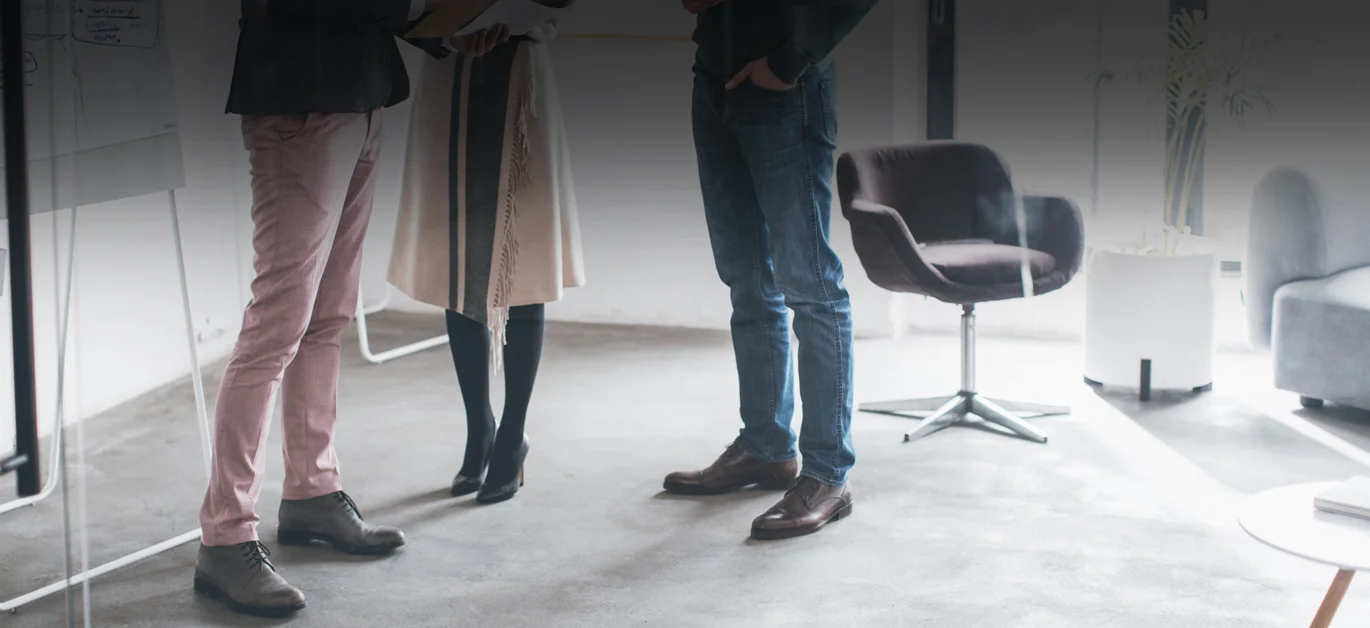
BLOG
Center Yourself and Your Team in 3 Minutes (or Less)
You know how it feels to begin a meeting when all the attendees are wildly distracted. Most leaders are in back-to-back meetings, with barely enough time to go to the bathroom let alone collect themselves and their thoughts to be fully available.
At some point you’ve also probably experienced a guided grounding exercise that helped you and others let go of the stressors and unprocessed emotions of the day. Maybe it was led by a meditation teacher, a yoga instructor or some other wellness guru. Whenever possible, it’s powerful to have this kind of guidance. But you could also lead a centering exercise on your own. You don’t have to be an expert, just bring your intent for clarity and calm and let this 3 minute script below do the rest. Suggestion: read it slowly.
You may have heard the phrase go slow to go fast. Before we get in to the content of today’s meeting, let’s deliberately slow down for a few minutes. For this you can have your eyes open or closed.
Start to notice your breathing. As you breathe, where does it go, where does it flow?
[pause]
Notice the speed. Notice the depth of each breath.
[pause]
Next I invite you to feel your seat on the seat…
Feel your feet on the floor.
Observe all other points of contact – perhaps your arm resting on the chair.
[pause]
Now if your body was divided front and back, how much of your energy and awareness is in front of you? How much energy and awareness do you have behind you?
[pause]
If your body was divided left and right, how evenly distributed are you between the two sides?
[pause]
Now I invite you to scan your entire body, as if you were looking at it on a radar screen. What parts of your body blip on that screen and get your attention? Notice any areas of tension or tightness.
[pause]
Now once again, observe the breath. Noticing its speed, its rhythm.
Notice the depth of each breath.
[pause]
And now we’ll slowly return to the room, no need to hurry.
Note: You might debrief immediately afterwards to help participants digest and internalize this self-awareness process. Just ask for a volunteer or two to share:
• How was that for you?
• What shifted in you as you slowed down to observe your body?
3 Critical Ways Leaders Increase and Access Alignment
Why Access Alignment, you ask? Aside from a love of alliteration, and a penchant for un-sexy brand names, I chose this name because it felt big enough to encapsulate three of the most important things we do:
1. Leading Purposefully: access alignment with your values
We continually witness and I’ve personally experienced how powerful it is to align purpose with path. When leaders align their values with their everyday actions:
- Everything falls into place.
- There is flow.
- Work can be done with greater ease, fulfillment and enjoyment.
- It’s not so heavy, burdensome or tiring.
- Impact multiplies.
2. Leading Fully as a Whole Person: access alignment with all parts of yourself
We know about IQ. We’re increasingly familiar with EQ and how this is essential for leading well. Very few understand or utilize SQ. In fact, what the heck is SQ?
SQ = soma (body) quotient. This is not even standard nomenclature yet but you’ve likely heard others touch on this untapped super power. Amy Cuddy, PhD taught us Power Poses. Bessel Van Der Kolk, MD explains how The Body Keeps the Score. And I learned from a decade of training in ZenBodytherapy® that our physical alignment - how we sit, stand and move - dramatically impacts how we think and feel. So increasing alignment physically and tapping into the brilliance of your body is something particularly potent. When you attune to all parts of yourself - head, heart and body:
- You connect more deeply with yourself, with others and the world around you.
- You increase empathy.
- You increase your capacity to be inclusive with others.
- It’s easier to create psychological safety.
- You know how to increase your own sense of safety in a world mired with triggers and trauma.
- You open doors and opportunities for yourself and for others.
3. Leading with Impact and Leverage: access alignment with others
When you’ve increased alignment within yourself, gaining alignment with others is a much easier, organic process. It’s far easier to craft a vision and embody it such that others are naturally drawn to it.
When you’ve done the groundwork of #1 and 2 above:
- You’re naturally more curious, humble, open and able to make adjustments or corrections when needed.
- You gain traction and influence.
- Generating or accessing alignment in your teams and in groups is easier and even exhilarating.
- Teamwork, collaboration, innovation, efficiency, and productivity soars.
What's Your Keystone Habit?
Keystone habits, a term coined by Charles Duhigg (author of The Power of Habit), are habits that automatically lead to multiple positive behaviors and positive effects in your life. When you anchor your day or your week with such a habit, it becomes the keystone that has a ripple effect into your activities and behaviors.
“Keystone habits say that success doesn’t depend on getting every single thing right, but instead relies on identifying a few key priorities and fashioning them into powerful levers.” Charles Duhigg
Colleagues sometimes perceived Sven* as threatening. His direct, no-nonsense communication style made him a powerful and productive asset to the sales organization. Due to the global nature of his team, he’d be on calls as early as 6am and again at 8 or 9pm after a full days work. He prided himself on working hard, but his personal life suffered and he internalized much of his stress. Before coaching began he already implemented healthy changes to his diet but it wasn’t enough to prevent the sharper interactions he had with peers and even a direct confrontation with his boss. Over the course of our coaching engagement, Sven experimented with changes to his day, both by saying no to added meetings and engagements – like volunteer boards. But the real change occurred when he resumed swimming on a daily basis. Even if it was just 20 minutes, starting his day this way made all the difference. He had more energy, could think clearly, became better at prioritizing and he even slept better at night. At times when he was on the road for work, he’d stop swimming and immediately his stress levels rose. So honing in on exercise no-matter-what was essential as a keystone.
In time Sven was able to keep his calm under stress. His ability to listen more deeply and empathize with others increased. A key turning point was during a high stakes sales implementation. The tech team felt demoralized and bullied by the sales groups who promised the world without having to shoulder the intricacies of building it out. Sven focused on becoming an ally for the tech team, naming the issues, ensuring voices were heard and then became arbiter for a solution that worked for the customer, sales and tech teams. Because he was no longer under-water himself - well, at least now only intentionally - he had a sense of humor and had time to think through meaningful ways to connect and appreciate others. He was proactive rather than reactive and this allowed his sincerity and thoughtfulness to shine through. In the final days of implementation he gave chocolate to each member of the tech team with a hand written note saying thank you. His victory was felt by his immediate teams and was also noticed by the most senior leaders of the company who tapped him for even bigger and exciting projects. He was promoted a few months later.
*In any case study, names are changed for client confidentiality.
Why you should get centered (with your team) at the start of a meeting
Have you heard the phrase or perhaps said it yourself - we’ve got to go slow to go fast?
Here’s one of my favorite ways to do just that. When I lead or facilitate a group coaching session, before we dive into the content of our session, we often start with a 3-minute guided self-awareness practice. Are you cringing? I was. Initially, anyway. Risky, right? Particularly with my most senior level sales leaders who had not dabbled in meditation. But when I tested the waters with them I was shocked with both the results and the response.
They became really quiet. And still.
Then they said: “Can we do that at the start of all of our calls?”
It was also surprising how much doing this helped me, even as leader of the call. I may have done my best to be present before getting on a call, but if the group was anxious or stressed, I would start feeling anxious too. I probably underestimated how much performativity was a factor. Whenever we really really want to do a good job - the body revs with stress hormones naturally even if we aren’t aware or attuned to it. Doing an awareness practice together helps everyone slow down, arrive, and let go of all the prior conversations, meetings and tasks.
I deliberately bring my clients attention to their body and their breath because I’ve found this to be the fastest way to help them (and me) settle the nervous system. It’s how we get “back online” out of anxiety or stress patterns. [For more background on how the brain and body react to uncertainty check out this short video]
Clients have not only asked for this, they’ve also emulated it at the start of their own meetings. They report the following results:
less fear and uncertainty
team is more engaged, connected
more intelligent and productive meetings
more collaboration and participation from everyone
we feel more relaxed, happier, flexible, fluid, creative
Intrigued and curious about this topic? Here’s a bit more on why presence matters and what one client taught me about the power of being still.
ps…
You don’t have to be a yoga teacher or meditation guru in order to guide the group. I’ve created a 3-minute script you can use. Easy peasy. Contact me if you’d like a copy.




